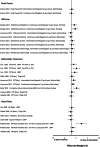Systematic review of the effectiveness of standalone passive countermeasures on microgravity-induced physiologic deconditioning
- PMID: 38664498
- PMCID: PMC11045828
- DOI: 10.1038/s41526-024-00389-1
Systematic review of the effectiveness of standalone passive countermeasures on microgravity-induced physiologic deconditioning
Abstract
A systematic review of literature was conducted to evaluate the effectiveness of passive countermeasures in ameliorating the cardiopulmonary and musculoskeletal effects of gravitational unloading on humans during spaceflight. This systematic review is the third of a series being conducted by the European Space Agency to evaluate the effectiveness of countermeasures to physiologic deconditioning during spaceflight. With future long-duration space missions on the horizon, it is critical to understand the effectiveness of existing countermeasures to promote astronaut health and improve the probability of future mission success. An updated search for studies examining passive countermeasures was conducted in 2021 to supplement results from a broader search conducted in 2017 for all countermeasures. Ground-based analogue and spaceflight studies were included in the search. A total of 647 articles were screened following removal of duplicates, of which 16 were included in this review. Data extraction and analysis, quality assessment of studies, and transferability of reviewed studies to actual spaceflight based on their bed-rest protocol were conducted using dedicated tools created by the Aerospace Medicine Systematic Review Group. Of the 180 examined outcomes across the reviewed studies, only 20 were shown to have a significant positive effect in favour of the intervention group. Lower body negative pressure was seen to significantly maintain orthostatic tolerance (OT) closer to baseline as comparted to control groups. It also was seen to have mixed efficacy with regards to maintaining resting heart rate close to pre-bed rest values. Whole body vibration significantly maintained many balance-related outcome measures close to pre-bed rest values as compared to control. Skin surface cooling and centrifugation both showed efficacy in maintaining OT. Centrifugation also was seen to have mixed efficacy with regards to maintaining VO2max close to pre-bed rest values. Overall, standalone passive countermeasures showed no significant effect in maintaining 159 unique outcome measures close to their pre-bed rest values as compared to control groups. Risk of bias was rated high or unclear in all studies due to poorly detailed methodologies, poor control of confounding variables, and other sources of bias (i.e. inequitable recruitment of participants leading to a higher male:female ratios). The bed-rest transferability (BR) score varied from 2-7, with a median score of 5. Generally, most studies had good BR transferability but underreported on factors such as control of sunlight or radiation exposure, diet, level of exercise and sleep-cycles. We conclude that: (1) Lack of standardisation of outcome measurement and methodologies has led to large heterogeneity amongst studies; (2) Scarcity of literature and high risk of bias amongst existing studies limits the statistical power of results; and (3) Passive countermeasures have little or no efficacy as standalone measures against cardiopulmonary and musculoskeletal deconditioning induced by spaceflight related to physiologic deterioration due to gravity un-loading.
© 2024. The Author(s).
Conflict of interest statement
The authors declare that the research was conducted in the absence of any commercial or financial relationships that could be construed as a potential conflict of interest. T.W. is employed by KBR GmbH on behalf of the European Space Agency. The funder KBR GmbH provided support in the form of salaries for the authors D.G. and T.W. but did not have any role in the study design, data collection, and analysis, decision to publish, or preparation of the manuscript. All authors declare that the research was conducted in the absence of any commercial, financial, or non-financial relationships that could be construed as a potential conflict of interest.
Figures


Similar articles
-
Effectiveness of nutritional countermeasures in microgravity and its ground-based analogues to ameliorate musculoskeletal and cardiopulmonary deconditioning-A Systematic Review.PLoS One. 2020 Jun 9;15(6):e0234412. doi: 10.1371/journal.pone.0234412. eCollection 2020. PLoS One. 2020. PMID: 32516346 Free PMC article.
-
Effect of Time on Human Muscle Outcomes During Simulated Microgravity Exposure Without Countermeasures-Systematic Review.Front Physiol. 2019 Aug 16;10:1046. doi: 10.3389/fphys.2019.01046. eCollection 2019. Front Physiol. 2019. PMID: 31474878 Free PMC article.
-
Effects of Spaceflight on Musculoskeletal Health: A Systematic Review and Meta-analysis, Considerations for Interplanetary Travel.Sports Med. 2021 Oct;51(10):2097-2114. doi: 10.1007/s40279-021-01496-9. Epub 2021 Jun 11. Sports Med. 2021. PMID: 34115344 Free PMC article.
-
Microgravity-induced changes in skeletal muscle and possible countermeasures: What we can learn from bed rest and human space studies.Exp Physiol. 2025 Mar 17. doi: 10.1113/EP092345. Online ahead of print. Exp Physiol. 2025. PMID: 40098289
-
Introducing the Concept of Exercise Holidays for Human Spaceflight - What Can We Learn From the Recovery of Bed Rest Passive Control Groups.Front Physiol. 2022 Jul 4;13:898430. doi: 10.3389/fphys.2022.898430. eCollection 2022. Front Physiol. 2022. PMID: 35874509 Free PMC article.
Cited by
-
SIRT5 Alleviates Apoptosis of Vascular Endothelial Cells Under Simulated Microgravity via Desuccinylation of ERO1A.Int J Mol Sci. 2025 Mar 23;26(7):2908. doi: 10.3390/ijms26072908. Int J Mol Sci. 2025. PMID: 40243486 Free PMC article.
-
Mechanical countermeasures for spaceflight-associated neuro-ocular syndrome during 30-days of head down tilt bed rest: design, implementation, and tolerability.Front Physiol. 2025 Feb 24;16:1530783. doi: 10.3389/fphys.2025.1530783. eCollection 2025. Front Physiol. 2025. PMID: 40066284 Free PMC article.
-
Structural and functional changes in the hippocampus induced by environmental exposures.Neurosciences (Riyadh). 2025 Jan;30(1):5-19. doi: 10.17712/nsj.2025.1.20240052. Neurosciences (Riyadh). 2025. PMID: 39800422 Free PMC article. Review.
-
Effects of fascial manipulation, vibration exercise, motor imagery, or neuro-muscular electrical stimulation on the coagulation system: A pilot study.Physiol Rep. 2025 Jan;13(1):e70165. doi: 10.14814/phy2.70165. Physiol Rep. 2025. PMID: 39744762 Free PMC article.
References
Publication types
LinkOut - more resources
Full Text Sources

